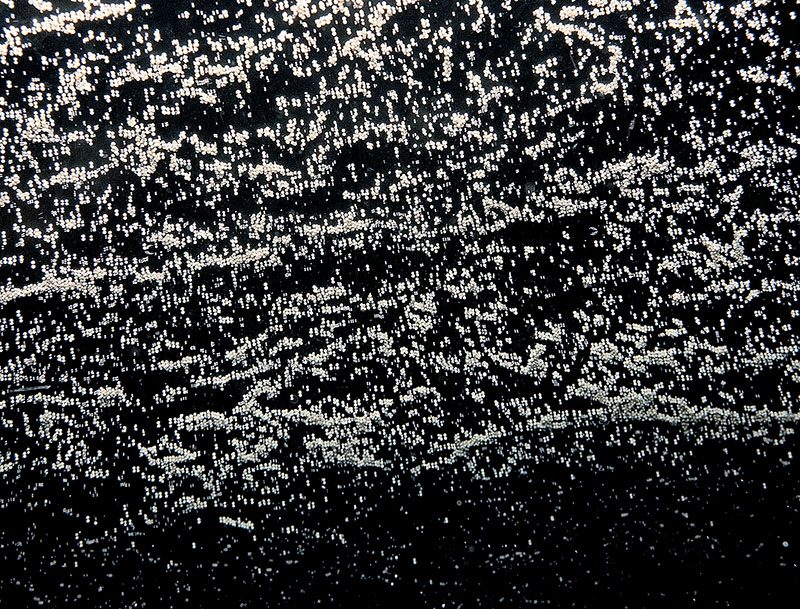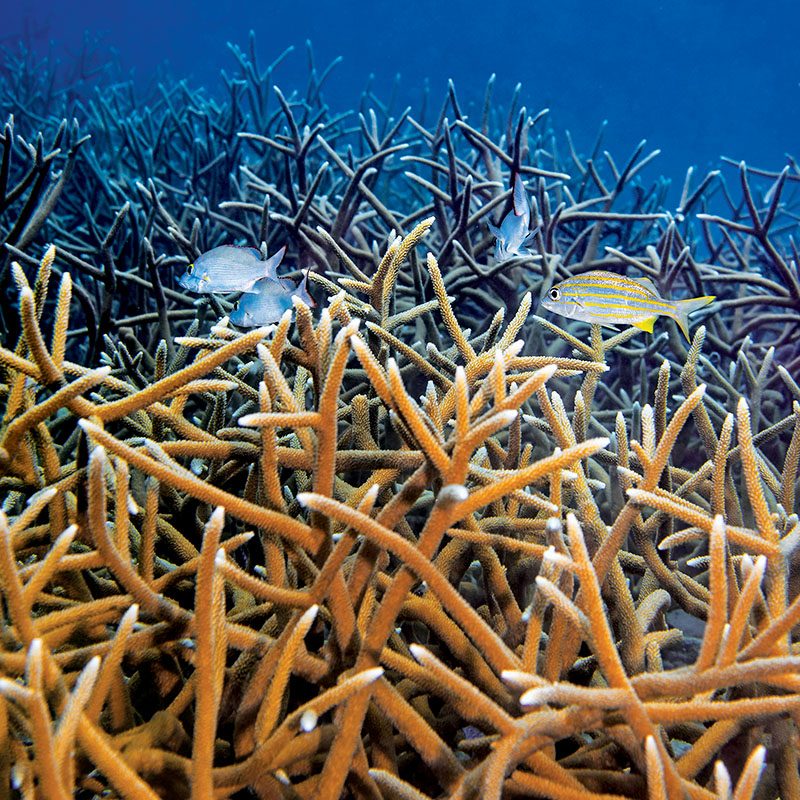To the delight of the divers staying at Tawali Resort on the shores of Milne Bay in Papua New Guinea, Anna’s hunch turns out to be right on track. Her premonition began with a late afternoon sighting of a sea star on its tiptoes exuding a long, lazy spiral of smokey spawn — a possible tip-off of coral spawning to come.
Peu après s'être séchée, Anna a tapé quelques touches rapides et a trouvé ce qu'elle espérait : Le frai annuel synchronisé des coraux sur la Grande Barrière de Corail, non loin au sud de nous, se produirait le quatrième soir après la pleine lune. Le moment est bien choisi. Quatre nuits plus tard, 20 d'entre nous ont effectué une plongée que nous n'oublierons jamais.
Entre 19 heures et 20 heures 30, de nombreuses espèces du genre ubiquiste Acropora — popularly known as staghorn, elkhorn, and plate-forming corals — launch their entire yearly reproductive payload. It is a single, eye-popping, synchronized mass spawning event cued by the moon phase, water temperature, and disparate factors conducive to a given region.
En un instant, la mer se remplit de centaines, puis de milliers, puis de millions de paquets de la taille d'une bille. Ils sont rosés et dodus, avec des œufs et du sperme, et montent inexorablement vers la surface pour repeupler les récifs coralliens proches et lointains. Bientôt, les multitudes s'unissent au-dessus, formant une nappe brillante qui s'étend aussi loin que la lumière de ma main peut atteindre.
On the ride back to the resort, our skiff of jubilant divers skims past slick after slick blanketing the bay’s wine-dark waters. The heroic sendoff of a new generation of corals into an environmentally uncertain world sends my mind wandering along with the specks of life.
As the rafts drift offshore, the bundles spill their gametes into a stewing brew of external fertilization. It’s all part of the sea’s grand strategy of synchronized broadcast spawning. This epic game plan provides stationary animals, such as reef-building stony corals and sponges, with high fertilization rates and an energy-efficient means of enhancing genetic diversity.
At the same time, the sheer flood of fat-filled food, which also includes the gametes of many mobile reef dwellers, overwhelms predators. While the top of the food chain is busy feasting, the lucky would-be prey can escape into the open sea, where fertilized embryos metamorphose into mobile larvae of many types. The corals’ version, known as planula larvae, are tiny, flattened, cilia-powered ovals packed with an inherent sense of destiny.




Many mysteries still surround the larvae’s eventual settlement onto stable, nearshore structures. The few survivors that make it back to the reef likely follow chemical clues exuded by members of their species, microbial microfilm, and crustose coralline algae — the calcifying glue of the reef.
Une fois installés, les vagabonds n'errent plus. En quelques jours, ils se transforment en polypes sédentaires, semblables à des sacs, avec des tentacules alimentaires entourant leur bouche. Les polypes commencent bientôt à déposer des squelettes de carbonate de calcium en forme de coupelles, appelés corallites, pour protéger leur corps vulnérable. Avec un peu de chance, les polypes bourgeonnent de manière asexuée des répliques d'eux-mêmes qui en engendrent d'autres jusqu'à ce que la colonie grandissante atteigne une maturité suffisante pour ajouter ses gamètes lors de la ponte annuelle. Mais tout n'est pas rose pour les nouveaux colons coralliens.
After a two-year pandemic hiatus, Anna and I arrive in Bonaire to witness the fall’s annual coral spawn. It had been more than 50 years since I first dived at this southern Caribbean island. In those days, massive staghorn and elkhorn thickets paralleled the calm western shoreline for miles. Today the famed offshore slope of boulder, brain, and finger corals still plunges regally from the shallows to 100 feet (30 meters), but the historic inshore thickets are no more. A wide, barren shelf scattered with broken coral rubble jutting from the sand like old bones spreads in their place. The culprits: warming water, bleaching, pollution and associated diseases, elevated storm surge, overfishing, coastal construction — I’ll stop there.
Certains parlent de la perte dévastatrice, dans toute la région, d'un habitat naturel complexe créé par des enchevêtrements titanesques d'arbres et d'arbustes. Acropora branches the “flattening of the Caribbean.” These labyrinths of untold hiding places have sheltered a flourishing sea of little fishes for ages. But in four short decades, they are gone forever. Or are they?
Today, not a stone’s throw from the resort’s dock, a staghorn thicket spreads across 4,000 square feet (372 square meters) of previously bare sand. This oasis of hope, which scientists and volunteers patched together piece by piece in 2013 using branches cultivated in a nearby underwater nursery of PVC trees, triumphantly spawned en masse in 2018.
Having been present at the initial planting by volunteer divers from Reef Renewal Foundation Bonaire, Anna and I have taken the site’s evolution to heart. As on previous visits, we conduct a Reef Environmental Education Foundation (REEF) fish survey on the revered patch. This year’s fish count ballooned to 32 species, and there was a notable increase in biomass inhabiting the dense thicket. Better yet, this restoration effort is far from the only one. With the combined force of the island’s dive operations, citizenry, legions of visitors, the National Parks Foundation of Bonaire, and the Dutch government, 41,000 pieces of coral nurtured in 11 nurseries have been laboriously outplanted on areas blanketing more than 100,000 square feet (9.290 square meters) of fallow sea floor, all in a short decade. Hurray for all of us!
© Alert Diver - Q1 2023